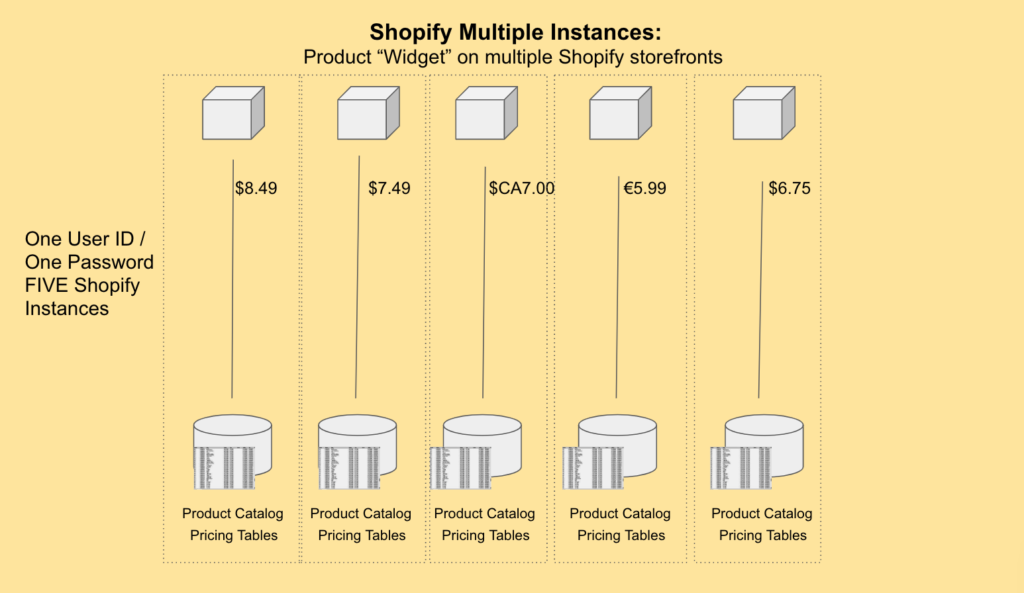Over the last decade, Accorin teams have delivered world-class e-commerce projects on a variety of different platforms, from Magento 1 and Magento 2, to Shopify, BigCommerce, Salesforce Commerce Cloud (Demandware), BigCommerce, DotNetNuke (DNN) and Volusion. We have a lot of experience on different platforms, their strengths, their weaknesses, and functional capabilities. We also get a lot of questions (and functional requests) around multistore. It’s one of those terms that might mean different things to different e-commerce merchants and platform architects. I recently heard Andrew Youderian (@youderian) of eCommerce Fuel (a GREAT podcast by the way) mention on a recent News Cart e-commerce news podcast that Shopify had launched “multistore” functionality in its most recent release. Shopifys lack of multistore capabilities has been a constraint for the platform, so I was interested to learn more. I asked a couple of our solution architects if they knew about the feature and what they thought it meant for merchants and other platforms like Magento (which leans on multistore heavily as a part of its value proposition for growing e). It turns out that multistore means very different things on Shopify and Magento. Both have value to merchants, but to merchants exploring both platforms for growth, it’s important to point out the current differences.
Shopify: What “Multistore” Means
First off, Multistore on Shopify is a feature that’s only available to Shopify Plus members. For regular Shopify merchants there are multistore plugins available that purport to offer multistore capability. But for the purposes of this comparison we are discussing the resident functionality within Shopify Plus. Based on what we have seen, Shopify’s multistore feature is essentially a handy Multistore Login feature that allows a Shopify merchant to use one set of credentials and login location to access and manage multiple Shopify storefronts. It is similar conceptually to a Single Sign On / SSO for Shopify. So we like to call Shopify’s current concept of Multistore. Multistore Login to different Shopify instances / storefronts.
The following diagram shows where product pricing updates (or updates to other content) would happen for a merchant with multiple Shopify storefronts.
Magento 2: What “Multistore” Means
Multistore on Magento 2 (including Community and Enterprise / Cloud) is a comprehensive and important aspect of its value proposition. It’s also very different than the Shopify concept. In Magento 2, multistore is really more than one feature, it is an approach that allows merchants to operate multiple storefronts from the same instance of Magento, using the same product and catalog database. Like Shopify a merchant can obviously login to multiple storefronts using the same credentials because they are logging into one instance of Magento. Basically, when you login to Magento, you can see all of your customers, orders, products and configuration information in one place for all your stores (with filtering to see just a single store’s info). No need to logout and then login to another store.The implications for the Magento version of Multstore are important for a merchant considering a multi-storefront expansion and or a global expansion. There are obviously positive benefits from the perspective of efficiency managing one catalog database while still being able to control and manage different prices and product attributes for different storefronts. But in addition, the Magento multistore model allows a merchant to have multiple teams working on different storefronts and those team members can be restricted in terms of access to other storefronts. This model allows an expansion-minded merchant with complex catalog requirements to manage multiple complex e-commerce businesses from one interface.
The following diagram shows where product pricing updates (or updates to other content) would happen for a merchant with multiple Magento storefronts.
Shopify vs. Magento Multistore Features Table
| Shopify | Magento | |
| Single Sign-on to multiple Stores | ✔ | ✔ |
| Single view of Orders across multiple store in Admin | ✖ | ✔ |
| Single view of Customers across multiple store in Admin | ✖ | ✔ |
| Single view of Customers across multiple store in Admin | ✖ | ✔ |
| Single view of Invoices across multiple store in Admin | ✖ | ✔ |
| Single view of Returns across multiple store in Admin | ✖ | ✔ |
| Single view of Shipments across multiple store in Admin | ✖ | ✔ |
| Configuration of multiple stores in the same Admin | ✖ | ✔ |
| Install and reuse of apps on multiple stores via the same Admin | ✖ | ✔ |
| Products can be setup and merchandised for multiple stores | ✖ | ✔ |
| Product inventory can be allocated and managed for multiple stores | ✖ | ✔ |
| Reporting on a single store | ✔ | ✔ |
| Reporting across multiple stores | ✖ | ✔ |
Implications for Shopify and Magento Merchants
The Multistore Login feature that Shopify Plus merchants can now take advantage of is a huge improvement for existing Shopify merchants that had to (prior to this feature) log in to multiple stores to manage them. This persistent single sign on type of functionality is going to save Shopify merchants time. Magento merchants or merchants considering Magento should understand that unlike in Shopify, if you want to open a new store using a similar catalog to current business, you can use the same instance of Magento and open a new storefront and manage them from the same interface. For complex B2B or B2C organizations with different brands, global expansion plans, multilanguage plans this is an important architectural capability and it is very different and more comprehensive than Shopify’s Multistore concept.
The Bottom Line
Shopify’s Multistore approach and Magento’s Multistore approach are very different. Make sure that you understand the differences of each approach, and their benefits/limitations, before you commit to either platform, or before you commit to a specific e-commerce growth path that includes multiple brands or businesses.




